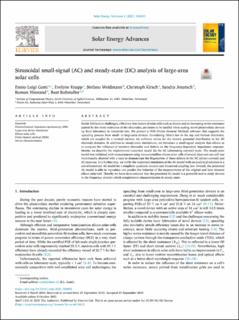Please use this identifier to cite or link to this item:
https://doi.org/10.21256/zhaw-23382Full metadata record
| DC Field | Value | Language |
|---|---|---|
| dc.contributor.author | Comi, Ennio | - |
| dc.contributor.author | Knapp, Evelyne | - |
| dc.contributor.author | Weidmann, Stefano | - |
| dc.contributor.author | Kirsch, Christoph | - |
| dc.contributor.author | Jenatsch, Sandra | - |
| dc.contributor.author | Hiestand, Roman | - |
| dc.contributor.author | Ruhstaller, Beat | - |
| dc.date.accessioned | 2021-11-03T11:48:02Z | - |
| dc.date.available | 2021-11-03T11:48:02Z | - |
| dc.date.issued | 2021 | - |
| dc.identifier.issn | 2667-1131 | de_CH |
| dc.identifier.uri | https://digitalcollection.zhaw.ch/handle/11475/23382 | - |
| dc.description.abstract | Beside fabrication challenges, efficiency loss factors of solar cells such as shunts and an increasing series resistance caused by the sheet resistance of the electrodes, are issues to be tackled when scaling novel photovoltaic devices up from laboratory to industrial size. We present a FEM (Finite Element Method) software that supports the upscaling process from small- to large-area devices. Considering Ohm’s law in the top and bottom electrodes, which are coupled by a vertical current, the software solves for the electric potential distribution in the 2D electrode domains. In addition to steady-state simulations, we introduce a small-signal analysis that allows us to compute the influence of resistive electrodes and defects on the frequency-dependent impedance response. Herein, we describe the implemented numerical model for the AC (alternating current) mode. The steady-state model was validated with measurements using monocrystalline silicon solar cells of several sizes and one cell was intentionally shunted with a laser to demonstrate the fingerprints of these defects in the DC (direct current) and AC response. In a further step, we verify the numerical simulation of the AC model with an analytical solution to a one-dimensional AC model for a simplistic quadratic domain and linearized coupling law. Overall, the presented AC model is able to reproduce and predict the behavior of the measurements of the original and later shunted silicon solar cell. Thereby we have demonstrated that the presented AC model is a powerful tool to study devices in the frequency domain which complements characterization in steady-state. | de_CH |
| dc.language.iso | en | de_CH |
| dc.publisher | Elsevier | de_CH |
| dc.relation.ispartof | Solar Energy Advances | de_CH |
| dc.rights | http://creativecommons.org/licenses/by-nc-nd/4.0/ | de_CH |
| dc.subject | Electrochemical impedance spectroscopy (EIS) | de_CH |
| dc.subject | Large-area device simulation | de_CH |
| dc.subject | Device characterization | de_CH |
| dc.subject | Finite element method (FEM) | de_CH |
| dc.subject | Silicon solar cell | de_CH |
| dc.subject.ddc | 621.3: Elektro-, Kommunikations-, Steuerungs- und Regelungstechnik | de_CH |
| dc.title | Sinusoidal small-signal (AC) and steady-state (DC) analysis of large-area solar cells | de_CH |
| dc.type | Beitrag in wissenschaftlicher Zeitschrift | de_CH |
| dcterms.type | Text | de_CH |
| zhaw.departement | School of Engineering | de_CH |
| zhaw.organisationalunit | Institute of Computational Physics (ICP) | de_CH |
| dc.identifier.doi | 10.1016/j.seja.2021.100003 | de_CH |
| dc.identifier.doi | 10.21256/zhaw-23382 | - |
| zhaw.funding.eu | No | de_CH |
| zhaw.issue | 100003 | de_CH |
| zhaw.originated.zhaw | Yes | de_CH |
| zhaw.publication.status | publishedVersion | de_CH |
| zhaw.volume | 1 | de_CH |
| zhaw.publication.review | Peer review (Publikation) | de_CH |
| zhaw.webfeed | Photovoltaik | de_CH |
| zhaw.author.additional | No | de_CH |
| zhaw.display.portrait | Yes | de_CH |
| Appears in collections: | Publikationen School of Engineering | |
Files in This Item:
| File | Description | Size | Format | |
|---|---|---|---|---|
| 2021_Comi-etal_Signal-analysis-solar-cells_SolarEnergyAdvances.pdf | 2.15 MB | Adobe PDF |  View/Open |
Show simple item record
Comi, E., Knapp, E., Weidmann, S., Kirsch, C., Jenatsch, S., Hiestand, R., & Ruhstaller, B. (2021). Sinusoidal small-signal (AC) and steady-state (DC) analysis of large-area solar cells. Solar Energy Advances, 1(100003). https://doi.org/10.1016/j.seja.2021.100003
Comi, E. et al. (2021) ‘Sinusoidal small-signal (AC) and steady-state (DC) analysis of large-area solar cells’, Solar Energy Advances, 1(100003). Available at: https://doi.org/10.1016/j.seja.2021.100003.
E. Comi et al., “Sinusoidal small-signal (AC) and steady-state (DC) analysis of large-area solar cells,” Solar Energy Advances, vol. 1, no. 100003, 2021, doi: 10.1016/j.seja.2021.100003.
COMI, Ennio, Evelyne KNAPP, Stefano WEIDMANN, Christoph KIRSCH, Sandra JENATSCH, Roman HIESTAND und Beat RUHSTALLER, 2021. Sinusoidal small-signal (AC) and steady-state (DC) analysis of large-area solar cells. Solar Energy Advances. 2021. Bd. 1, Nr. 100003. DOI 10.1016/j.seja.2021.100003
Comi, Ennio, Evelyne Knapp, Stefano Weidmann, Christoph Kirsch, Sandra Jenatsch, Roman Hiestand, and Beat Ruhstaller. 2021. “Sinusoidal Small-Signal (AC) and Steady-State (DC) Analysis of Large-Area Solar Cells.” Solar Energy Advances 1 (100003). https://doi.org/10.1016/j.seja.2021.100003.
Comi, Ennio, et al. “Sinusoidal Small-Signal (AC) and Steady-State (DC) Analysis of Large-Area Solar Cells.” Solar Energy Advances, vol. 1, no. 100003, 2021, https://doi.org/10.1016/j.seja.2021.100003.
Items in DSpace are protected by copyright, with all rights reserved, unless otherwise indicated.